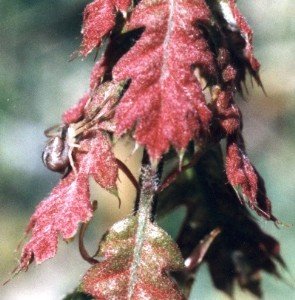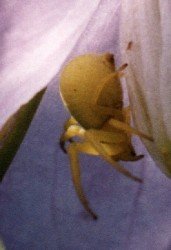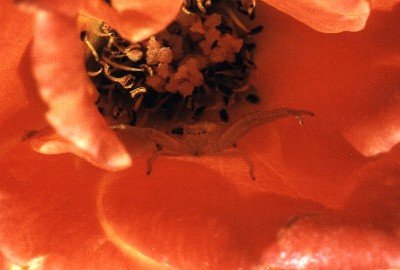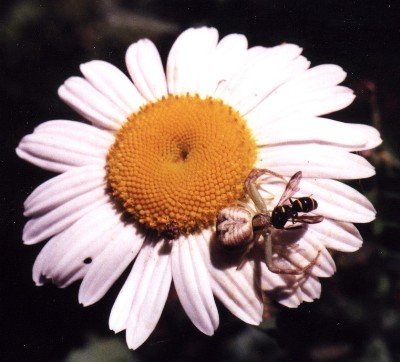
 The archetypal ambush hunter of the arachnids is undoubtedly the crab spider. There are around 200 species in North America, but it is very hard to tell whether or not an individual spider is a different species because they are so varied in their coloration. With habits similar to the green lynx, crab spiders take it one step further. While the green lynx usually ambushes prey, it also sometimes hunts actively, and it cannot alter its coloration. Crab spiders, on the other hand, are very slow moving and therefore ineffectual hunters. They are built to simply wait and grab. Making them even more efficient at staying hidden from prey, they are capable of slowly altering their colors to match surrounding plants.
The archetypal ambush hunter of the arachnids is undoubtedly the crab spider. There are around 200 species in North America, but it is very hard to tell whether or not an individual spider is a different species because they are so varied in their coloration. With habits similar to the green lynx, crab spiders take it one step further. While the green lynx usually ambushes prey, it also sometimes hunts actively, and it cannot alter its coloration. Crab spiders, on the other hand, are very slow moving and therefore ineffectual hunters. They are built to simply wait and grab. Making them even more efficient at staying hidden from prey, they are capable of slowly altering their colors to match surrounding plants.

I must admit that I find crab spiders to be rather repulsive, especially when one is in the house crawling with its grotesque gait across a tile floor. Their squat body shape and ungainly legs do resemble some types of crabs. Crab spiders are easy to identify since their first two pairs of legs are much longer than the others. Females are larger than males and their bodies can be almost round. Males have much longer legs, are smaller and have smaller bodies. All the crab spiders in our area are smaller than ½ inch.

Because they are often found on flowers, another name for crab spiders is flower spiders. I've often been surprised to find a spider hiding in a blossom that I was looking at, so well are they usually camouflaged. I was once photographing a millipede in a flower and only after getting the film developed and printed did I notice a tiny crab spider on the tip of one of the petals. Every so often I've also seen the spiders in places other than flowers (and other than in our house), usually on small leaves in trees.

Crab spiders have a characteristic stance they maintain while waiting for unsuspecting insects. They anchor themselves with their smaller back four legs and spread their long front four legs like a trap. Even though they are supposed to be rather nearsighted, and rely on blending into their surroundings to catch food, about half the time that I approach them with a camera, they discretely climb around to the underside of their perch, so they are quite wary of predators.

While the spiders in this area usually range from white to brown, along with all sorts of colors and patterns in between, yellow is also a common color. The spiders don't just have one color; they usually have an ornate pattern on their back, which somehow, even though it doesn't always match the vegetation, makes them blend right into the background.
 Female crab spiders, like many other species, will continue to guard their egg case after it has been laid. They usually deposit it under a leaf and I've never found one, probably because they are not very large. The spiders are efficient hunters and, waiting in flowers, often ambush such prey as flies, bees, wasps, and other nectar seeking insects. Their venom is powerful enough to quickly subdue prey much larger than themselves so they don't wrap it in silk. These interesting spiders are very common, but their small size and cryptic coloration often make finding them a challenge.
Female crab spiders, like many other species, will continue to guard their egg case after it has been laid. They usually deposit it under a leaf and I've never found one, probably because they are not very large. The spiders are efficient hunters and, waiting in flowers, often ambush such prey as flies, bees, wasps, and other nectar seeking insects. Their venom is powerful enough to quickly subdue prey much larger than themselves so they don't wrap it in silk. These interesting spiders are very common, but their small size and cryptic coloration often make finding them a challenge.

|


 The archetypal ambush hunter of the arachnids is undoubtedly the crab spider. There are around 200 species in North America, but it is very hard to tell whether or not an individual spider is a different species because they are so varied in their coloration. With habits similar to the green lynx, crab spiders take it one step further. While the green lynx usually ambushes prey, it also sometimes hunts actively, and it cannot alter its coloration. Crab spiders, on the other hand, are very slow moving and therefore ineffectual hunters. They are built to simply wait and grab. Making them even more efficient at staying hidden from prey, they are capable of slowly altering their colors to match surrounding plants.
The archetypal ambush hunter of the arachnids is undoubtedly the crab spider. There are around 200 species in North America, but it is very hard to tell whether or not an individual spider is a different species because they are so varied in their coloration. With habits similar to the green lynx, crab spiders take it one step further. While the green lynx usually ambushes prey, it also sometimes hunts actively, and it cannot alter its coloration. Crab spiders, on the other hand, are very slow moving and therefore ineffectual hunters. They are built to simply wait and grab. Making them even more efficient at staying hidden from prey, they are capable of slowly altering their colors to match surrounding plants.




 Female crab spiders, like many other species, will continue to guard their egg case after it has been laid. They usually deposit it under a leaf and I've never found one, probably because they are not very large. The spiders are efficient hunters and, waiting in flowers, often ambush such prey as flies, bees, wasps, and other nectar seeking insects. Their venom is powerful enough to quickly subdue prey much larger than themselves so they don't wrap it in silk. These interesting spiders are very common, but their small size and cryptic coloration often make finding them a challenge.
Female crab spiders, like many other species, will continue to guard their egg case after it has been laid. They usually deposit it under a leaf and I've never found one, probably because they are not very large. The spiders are efficient hunters and, waiting in flowers, often ambush such prey as flies, bees, wasps, and other nectar seeking insects. Their venom is powerful enough to quickly subdue prey much larger than themselves so they don't wrap it in silk. These interesting spiders are very common, but their small size and cryptic coloration often make finding them a challenge.